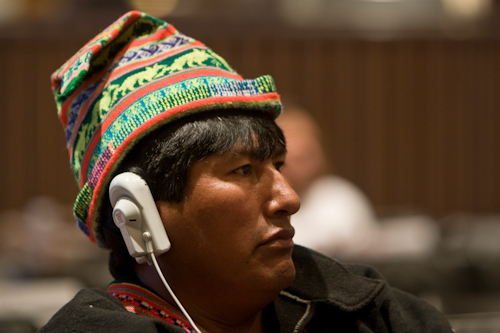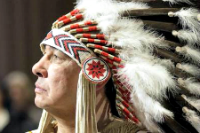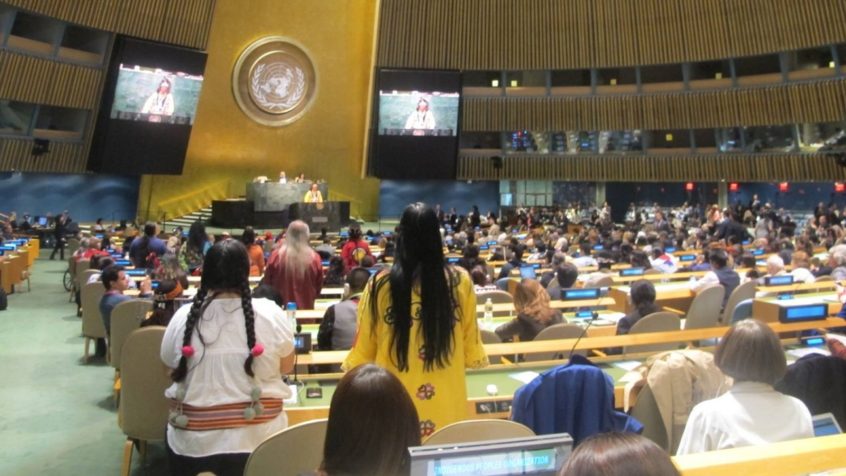SWAP Action Areas
 In the outcome document of the 2014 high-level plenary meeting of the General Assembly known as the World Conference on Indigenous Peoples, the Assembly requested the Secretary-General to develop, within existing resources, a system-wide action plan to ensure a coherent approach to achieving the ends of the United Nations Declaration on the Rights of Indigenous Peoples. The system-wide action plan was developed following consultations with indigenous peoples, Member States and the Inter-Agency Support Group on Indigenous Peoples’ Issues.
In the outcome document of the 2014 high-level plenary meeting of the General Assembly known as the World Conference on Indigenous Peoples, the Assembly requested the Secretary-General to develop, within existing resources, a system-wide action plan to ensure a coherent approach to achieving the ends of the United Nations Declaration on the Rights of Indigenous Peoples. The system-wide action plan was developed following consultations with indigenous peoples, Member States and the Inter-Agency Support Group on Indigenous Peoples’ Issues.
The elements of the action plan, as per document E/C.19/2016/5, are the following:
1. Raise awareness of the Declaration on the Rights of Indigenous Peoples
A) Conduct a high-level awareness-raising initiative
The Secretary-General and other high-level United Nations officials will use their good offices to raise awareness of the United Nations Declaration on the Rights of Indigenous Peoples. Drawing upon key messages to be drafted and relevant recommendations made by the international human rights system, the indigenous-specific United Nations mechanisms and other relevant agencies, officials and spokespersons will reiterate the commitment of the United Nations system to the Declaration and its provisions and encourage ratification of ILO Convention No. 169. Activities will include advocacy and awareness-raising in speeches and statements, letters to United Nations country teams and others in the United Nations system, bilateral meetings with Member States and visits to indigenous peoples’ communities. Substantive support to the Executive Office of the Secretary-General will be provided by the Department of Economic and Social Affairs.
B) Develop a succinct set of key messages based on the Declaration on the Rights of Indigenous Peoples
In the context of the awareness-raising initiative described above, messages will be developed that express the commitment of the United Nations system to the Declaration and to supporting its implementation. These messages will be aimed at raising awareness and building support for the rights of indigenous peoples among all key stakeholders at all levels (Member States, United Nations personnel, relevant civil society organizations and the general public). The messages should be derived from the Declaration and should be presented in a coherent manner that is useful to policymakers and practitioners. The messages will be developed by the Department of Economic and Social Affairs and the Department of Public Information in collaboration with members of the Inter-Agency Support Group.
C) Develop and launch a media and outreach campaign
In support of the high-level awareness-raising initiative, and taking advantage of existing communication channels within the United Nations system, a media and outreach campaign should be developed and undertaken using social media, United Nations websites, United Nations radio and television and other platforms, based on the agreed key messages. This could include infographics, photos, videos, exhibits, fact sheets, stories and opinion editorials by United Nations experts on indigenous peoples. This may also include the nomination of high-level or prominent champions of indigenous peoples, such as indigenous artists, actors, politicians and other public figures. This strategy will engage the network of United Nations information centres, services and offices in proactive promotion of United Nations activities vis-à-vis indigenous issues at the country and regional levels. This strategy will be developed by the Department of Public Information in close collaboration with the Department of Economic and Social Affairs and in cooperation with other interested United Nations partners.
To learn more about the implementation of Element 1 click here
2. Support the implementation of the Declaration on the Rights of Indigenous Peoples
A) Support national partners in the reform and implementation of legal frameworks, policies, strategies and plans to further the Declaration on the Rights of Indigenous Peoples, through joint programming and other initiatives
In the outcome document of the World Conference on Indigenous Peoples, Member States committed to developing and implementing national action plans, strategies and other measures to achieve the ends of the Declaration. They also committed to taking measures at the national level, including legislative, policy and administrative measures, to achieve the ends of the Declaration. Building on these commitments, Member States invited United Nations agencies, funds and programmes to support the implementation of national action plans, strategies and other measures to achieve the ends of the Declaration. United Nations country teams, the United Nations Development Programme and other agencies, funds and programmes will engage with Member States to support and promote these activities in cooperation with other interested United Nations partners.
B) Support the mainstreaming of the Declaration on the Rights of Indigenous Peoples and International Labour Organization Indigenous and Tribal Peoples Convention, 1989 (No. 169) in national development plans and in common country assessments and United Nations Development Assistance Frameworks
In applying a human rights-based approach in its work with national partners and through the United Nations Development Assistance Frameworks in particular, United Nations country teams, in cooperation with other United Nations system partners, will promote the mainstreaming of indigenous peoples’ rights. The United Nations Development Group programming principle of following a human rights-based approach, the Development Group Guidelines on Indigenous Peoples’ Issues and the resource kit on indigenous peoples’ issues provide a road map and tools for integrating indigenous peoples’ issues into processes for programmes at the country level, including processes aimed at implementing the 2030 Sustainable Development Agenda. United Nations country teams through their work will also promote recommendations pertaining to indigenous peoples emerging out of human rights mechanisms, including human rights treaty bodies, ILO supervisory bodies, special procedure mandates and the universal periodic review. Members of the Inter‑Agency Support Group will ensure that United Nations country teams have access to expertise, data and other relevant sources of information on the rights of indigenous peoples in the preparation of common country assessments and Development Assistance Frameworks and in the 2030 Sustainable Development Agenda national level processes.
C) Promote the establishment or strengthening of consultative mechanisms and platforms of dialogue under the leadership of the resident coordinators
These consultative mechanisms will inform the operational activities of the United Nations country teams. They will also promote regular dialogue between indigenous peoples, State actors, the private sector and other relevant entities to foster trust and to advance the rights of indigenous peoples. Dialogues may also be held at the regional and global levels with relevant partners, such as intergovernmental regional mechanisms, development banks and regional inter‑agency mechanisms. Support can also be delivered through the generation of evidence, analysis and knowledge exchanges related to indigenous peoples.
To learn more about the implementation of Element 2 click here
3. Support the realization of indigenous peoples’ rights in the implementation and review of the 2030 Agenda
The 2030 Agenda for Sustainable Development aims to leave no one behind and to reach the furthest behind first. As a general principle, it is important to ensure that efforts by the United Nations system to assist Member States to achieve the Sustainable Development Goals include, where possible, a focus on indigenous peoples, who are among the furthest behind. Specifically the United Nations system should:
(a) Incorporate indigenous issues into programming to implement the 2030 Agenda and ensure such programming is consistent with the provisions of the Declaration on the Rights of Indigenous Peoples;
(b) Promote the participation of indigenous peoples in programmes, projects and other activities related to the implementation and review of the 2030 Agenda, including the participation of indigenous women, persons with disabilities, older persons, children and youth;
(c) Where possible, ensure that information is gathered and disseminated on progress in implementing the 2030 Agenda for indigenous peoples.
To learn more about the implementation of Element 3 click here
4. Map existing UN standards, materials and resources for the effective implementation of the UNDRIP
The United Nations system is already engaged in promoting the implementation of the Declaration on the Rights of Indigenous Peoples through a range of activities. These include the collection and dissemination of information on the situation of indigenous peoples, with particular emphasis on research, statistical data collection, policy development and analysis, reports to human rights bodies and mechanisms and training materials. Some international agreements contain indicators of relevance to indigenous peoples and these are being put into operation, such as on traditional knowledge. Several organizations have either adopted specific policies and mechanisms of engagement with indigenous peoples or are in the process of doing so.
An exercise to map this wealth of information will not only provide an overview of the United Nations system’s activities related to indigenous peoples, but will also support the creation of a central hub of information on indigenous peoples’ issues within the system, for use by all partners. This would serve the purpose of identifying existing resources for effective and coherent action on indigenous peoples’ issues and also facilitate the identification of gaps in knowledge and capacity for informed decision-making on further investments in resources for gathering evidence and developing capacity. For continuous updating of the proposed knowledge hub, this information will be provided each year by members of the Inter-Agency Support Group and consolidated by the Department of Economic and Social Affairs as part of the annual report to the annual sessions of the Permanent Forum on Indigenous Issues and other forums as requested.
To learn more about the implementation of Element 4 click here
5. Develop the capacities of States, indigenous peoples, civil society and UN personnel
A) Integrate indigenous peoples’ issues into existing capacity development activities
The United Nations system already provides a wealth of training opportunities, including training in the human rights-based approach to programming, results-based management, monitoring and evaluation and training in the specific fields of each United Nations entity. Indigenous issues should be incorporated into these capacity development activities, as appropriate.
This should ensure, where appropriate and feasible: (a) common messaging in line with the Declaration; and (b) coordination within the United Nations system in terms of organization and production of materials. Capacity development will highlight the coherence and complementarity of the Declaration, ILO Convention No. 169 and core United Nations human rights treaties. This will be implemented by all relevant organizations that conduct capacity development, including the United Nations System Staff College.
B) Develop the capacities of United Nations staff at all levels
Initiatives will include:
(1) Technical capacity development in drafting and revision of national policy that is inclusive and consistent with the Declaration on the Rights of Indigenous Peoples, ILO Convention No. 169 and human rights treaties and standards, and in building on the United Nations Development Group Guidelines on Indigenous Peoples’ Issues;
(2) Regional and subregional training activities or programmes carried out through the regional commissions and through the United Nations Development Group regional directors team’s quality support and assurance group. Collaboration in this regard with regional institutions like the regional banks and regional and subregional organizations that have programmes dealing with indigenous peoples would be promoted;
(3) Online capacity development on indigenous issues. Online training and, where possible, accredited training, using train-the-trainer methodologies, to be developed as tools aimed at and for United Nations staff.
C) Capacity development for Member State officials
Indigenous peoples and Member States have identified a lack of knowledge about indigenous peoples and their issues and rights as one of the major obstacles to the implementation of the Declaration on the Rights of Indigenous Peoples. Capacity development of Member State officials should be accommodated in projects that target indigenous peoples, as well as other United Nations initiatives.
D) Training representatives of indigenous people’s institutions and organizations
Some indigenous peoples lack the skills, access and resources to advocate effectively for their rights and well-being. It is important to focus specifically on indigenous peoples, especially those with a capacity to train others and disseminate information, from countries and/or communities that have limited access to resources. The Office of the United Nations High Commissioner for Human Rights and the World Intellectual Property Organization have dedicated indigenous fellowship programmes, and various other United Nations entities, including the Secretariat for the Convention on Biological Diversity and the United Nations Institute for Training and Research, organize trainings for indigenous peoples.
Support to indigenous-led capacity development through trainings should also be provided and integrated into development initiatives targeting indigenous peoples. All capacity development exercises aimed at indigenous peoples should include the participation of indigenous women, indigenous persons with disabilities and indigenous children and youth.
To learn more about the implementation of Element 5 click here
6. Advance the participation of indigenous peoples in United Nations processes
Although the participation of indigenous peoples’ representatives and institutions in meetings of relevant United Nations bodies is a matter that the General Assembly will continue to consider, the United Nations system can take concrete and practical steps towards increased full and effective participation in processes that affect them. This can include consultative mechanisms, funds and tools for seeking free, prior and informed consent and other means for facilitating full and effective participation of indigenous peoples, including indigenous women, elders, persons with disabilities and indigenous children and youth.
To learn more about the implementation of Element 6 click here
To learn more about the SWAP implementation click here


